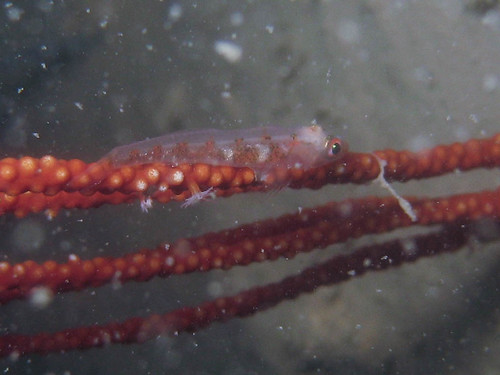The Silt Thickens
 June 9, 2013
June 9, 2013

The heavy loading of silt in Singapore waters can make it a real challenge for the larvae of many marine flora and fauna to settle onto the reef habitat, where they need to secure themselves to in order to feed and mature. Just imagine you’re trying to plant flowers in a garden that’s getting rained on all the time!

Yet, this underwater garden continues to spring with life! Just look at this section of a sea fan that is covered with tens of tiny brittle stars!

I’m a big fan of Black coral. They are usually found in deep water, but in Singapore we can find them in shallow parts of the reef. Unlike other hard corals, black coral get its name from the distinctive black or dark brown color of its skeleton. There are over 200 species of black coral and their polyps can be a range of colours from red to yellow and white (above). Black coral is listed in Appendix II of the Convention on International Trade in Endangered Species (CITES).

Check out this squat lobster that’s hiding in a crinoid! Are these critters just commensals or are they parasites?

This Icon sea star most certainly has a parasite.

Related to sea stars, basket stars may look like they have dozens of arms when in fact they only have five. Part of the reason is that the branches are branched, too. The repeated branching eventually makes a creature that looks like a large, somewhat tangled ball of yarn. That is the nonfeeding daytime look. When basket stars feed the ball of yarn unfurls and the arms extend to make a basket-like or net-like sieve that catches plankton and other organic matter that passes. Tube feet arranged in regular patterns along each of the arms help basket stars catch their food and pass the food particles to their mouth. When feeding, basket stars are usually perched at prominent outcroppings or in high places in a reef community, and often they are seen on sea fans. [1]

Is this a species of Murex (predatory sea snail) that has its shell heavily encrusted with coral, hydroids, and sponges?

I found this mantis shrimp in a crinoid at first. Perhaps it was foraging in the crinoid? There is no record of mantis shrimp living in crinoids, the way shrimp do. As soon as I disturbed the crinoid, the mantis shrimp shot out of it and tucked its body into a crevice within this pink branching sponge. What was really interesting was that this mantis shrimp was exactly the same colour as the maroon-coloured crinoid within which it was found in. It is extremely well hidden if not for its golden eyes.

We encountered a huge flounder at Pulau Hantu. I put my hand right on it without realising it was there. Funny thing is the fish didn’t flinch at all! I only realised it was a fish because what looked like sand didn’t FEEL like sand. Only when I stared at the area under my palm for a few seconds did I spot the flounder!

A beautiful little Ceratosoma nudibranch.

The visibility was a little better at Pulau Hantu so we could appreciate the reef scape!

But the water was still turbid enough to allow me to sneak up real close to this filefish!

A cryptic Flase scorpionfish tries to blend into the reef at best, or mimic a venomous scorpionfish if that fails! Life on the reef is full of dangers and it helps to either BE threatening, and if not to at least LOOK threatening!
Here are the Tweets I posted from today’s expedition:
“The amazing thing abt sea grasses in Sg is how they survive living in the world’s busiest port!” Len Mckenzie, James Cook Uni #MegaMarine
With Catherine Head, Oxford Uni, & Zarina Zainul, NUS, after Day 7 of diving for the #MegaMarine Southern Expedtion! http://twitpic.com/ctkjbp
Isn’t it amazing, that amidst all this, there are living coral reefs? #megamarine http://twitpic.com/cudmuk
1st dive at Kusu: A whooping 1.5m visibility! Wuhoo! Squad lobsters, mantis & tozeuma shrimp, murex snails, & unusual ascidians #megamarine
Saw a mantis shrimp on a Crinoid. Got into my vial, but shot out just before I put the lid on. *#!@ #MegaMarine
Three new shrimp records for Singapore today at Kusu! Wicked! #MegaMarine
Here’s where the findings from our dives arrived to be sorted, labelled, & photographed! #MegaMarine http://twitpic.com/cufl8x
Good visibility at Pulau Hantu! Went deep to 20m, big flounder and small sand divers. Bullocki, cinta, ceratosoma. #MegaMarine
A view of the central business district from St Johns Island! #MegaMarine http://twitpic.com/cufma7
 Posted in
Posted in 



 content rss
content rss
COMMENTS